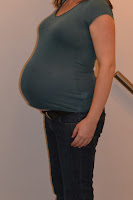Postnatal Fitness
Postnatal fitness – Introducing our new 6 week course
Starting on March 15th we are launching our first
6 week course ‘Mamas and Babas & Postnatal Fit’. It will be a 1 hour
class on Thursday’s at 11am, comprising of a 30 minute postnatal fitness
classes and a 30 minute baby class giving mums the opportunity to bond with
their new born through song, baby massage techniques and different sensory
experiences. Babies are welcome to join you whilst you are exercising either in
their car seat, in one of our baby bouncers or lying on a mat next to you and
giving their feedback as loudly as they like.
 |
| 9 Months pregnant |
After nine months of carrying around that precious cargo in
your tummy and now adapting to your new routine with the new addition you may
be looking at your pre-pregnancy clothes wondering when you are next going to
be able to squeeze into that little black dress. During pregnancy a woman’s
body goes through many physiological and anatomical changes and you should be
realistic about your recovery, it is not as easy as the media makes out and not
all exercise is suitable for postnatal woman.
There are numerous reasons to exercising after pregnancy including
the pschyological benefits ofVstress relief and assisting with emotional stability
as well as the physical benefit of repairing your body. But it is vital to
ensure that you do not do too much too soon and focus on restoring pelvic floor
function before undertaking strenuous exercise.
Diastasis recti affects approximately 30% of woman during
pregnancy and postpartum. A diastasis is where the left and right side of the
rectus abdominis separate at the linea alba thus reducing the strength of the
abdominals and causing pelvic instability which can lead to pelvic weakness and
incontinence as well as lower back pain. (in layman's terms, your tummy muscles don't knit back together immediately leaving a gap).The fitness aspect of the ‘Mamas and
Babas’ programme focuses on repairing the pelvic floor and improving core and
postural muscles through the hypopressive method.
 |
| Creating a vacuum using the Hypopressive technique. |
The hypopressive method was introduced to me through Marie
Behenna, my fabulous mentor and the author and creator of The Fitmama Method TM. Hypopressives involve breathing patterns and postures
to improve tone of core muscles and support the pelvic floor through low
pressure exercise. I have been asked if it is like yoga and pilates but
although some of the postures are similar hypos are unlike any other form of
exercise. Dr Marcel Caufriez, a Belgium doctor specialising in physio and rehab
developed the technique in 1980’s specifically for postnatal woman to repair
their pelvic floor after the stress it undertakes during pregnancy and
delivery.
 |
| Performing a shoulder bridge while performing a Hypopressive. |
Rushing back to non-specific exercise after giving birth can cause
more harm than good as most traditional abdominal exercises such as planks,
crunches, sit-ups etc. put excessive intra-abdominal pressure on the abdominal
wall which can accentuate pelvic weakness leading to urinary incontinence and
prolapse. However due to the low abdominal pressure hypopressives can safely be
used by post natal woman with weak pelvic floor muscles and diastasis recti and
is shown to improve pelvic function, repair diastasis, improve core stability,
strength and tone abdominals and even reduce the waistline. (In fact hypopressives
can be used by men and women alike as they can also help improve prostate
health on top of the core and waist size benefits for males)
If you would like more information about our postnatal fitness class, our pregnancy fitness sessions or how you can exercise with your children, please drop in to The Honeycomb Hub for a visit, send us an email on thehoneycombhub@outlook.com or give us a call on 75935900.
The Fitmama blog -blogging for fit and healthy parenting - is a great space to gain more information about pregnancy and post natal fitness https://thefitmamamethod.blog/



Comments
Post a Comment